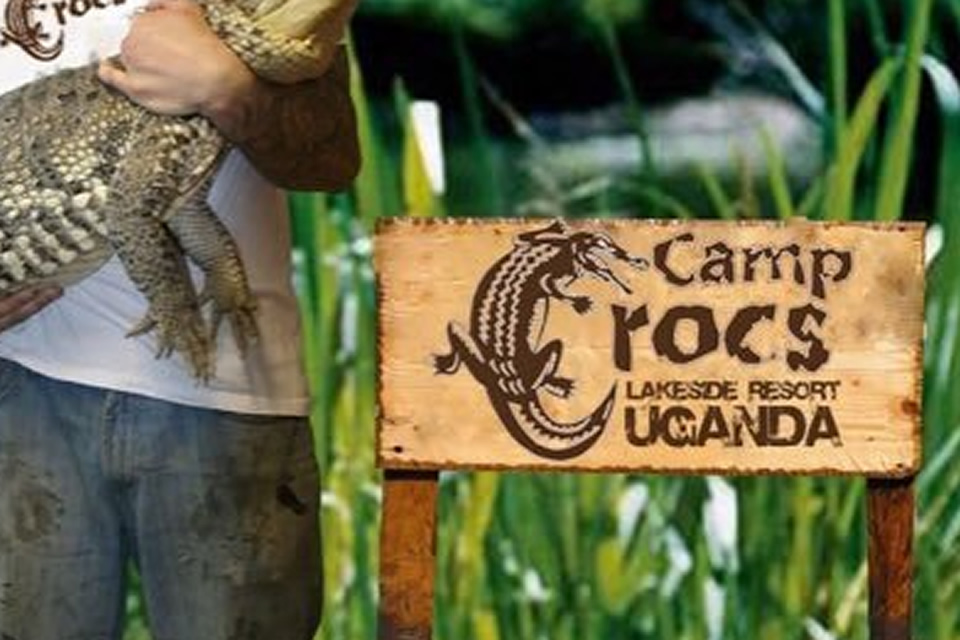Your cart is currently empty!

Sleep Amongst the Crocodiles at Camp Crocs
When you first drive up to the dusty door of Camp Crocs Ltd, you might not be sure what to expect. However, what you’ll find is so much more than just your average croc farm. Yes, there are about 3,200 live crocodiles running around their enclosures and wiggling into the water as you walk by. But what you may not expect is the lovely open leisure area that emerges just beyond the farming compound.
In the mid 1980’s, a scientist who had spent some time in Zimbabwean crocodile farms started Camp Croc Ltd. He came to Uganda and saw a substantially untapped market. Indeed, with Uganda boasting the highest concentration of crocodiles per square meter in the world, it seemed like a no-brainer to create a venture that worked in both conservation and harvesting.
The crocodiles are farmed from eggs gathered in Murchison Falls and heated at a particular temperature to produce mostly male crocs. They live on the farm, eating chicken and bathing in the sun. Then around four to five years of age, about 70% are farmed for their meat and skin, while approximately 20% are returned to the banks of the Nile (with the other 10% often not making it to adulthood). This method actually works to keep the Crocodile population stable, as in the wild, nearly 80% of crocs never make it past the first few years of life. The actual farming and culling of crocs takes place in December, so if you are morbidly curious as to what goes into skinning a croc, come then. The meat is then sold around to some of Kampala’s premier restaurants, such as The Lawns or Carnivore. The skin, which goes for a substantially higher price, is exported all around the world from Italy to South Korea.
Visitors to the farm will be treated to a vast array of crocs, aging from hatchlings, until about 5 years. As you pass the enclosures, you can see them lazing in their ponds and occasionally snapping at one another. If you dare (and ask nicely), you might even be able to hold one of the younger crocs, but be warned, they can take off a finger with very little effort.
Just past the main enclosures are the crocs brought in by the Uganda Wildlife Association. These are man-eaters who, instead of being killed, are taken into the farm where they can live the rest of their lives without distressing the surrounding population. One of the larger man-eaters, Benjamin, is a 50 year old croc that is said to have killed 18 people before coming to the farm. Other large crocs, such as Romeo and Julie were saved from inhumane living conditions. Julie, the larger female croc, will actually come when you call, swimming up from the pond, walking right up to the fence, and hissing at you.
Venture further into Camp Crocs and you see the concrete housing units give way to a lakeside park. Large open grassy areas with picnic tables, swings, slides, and a fire pit come into view. Four spacious, and clean cabins with room for couples, a group of friends, or a whole family, line the hill. Just beside the cabins is the restaurant. With a pool table and indoor seating (if it happens to rain) or plenty of outside seating if weather permits. If you come on the weekends, you will find the freshest crocodile meat and a jovial atmosphere. University students, families, friends and couples are all a common sight. There is also a large grassy field where people can camp in their own tents, or play sports if they bring a football or Frisbee.
Canoes and small boats are also available (with life jackets) for those looking to head out onto Lake Victoria. Despite such a large amount of crocodiles nearby, it is perfectly safe to swim around the campsite. There is a natural, grass covered jetty that is also perfect for picnics and fishing (poles provided).
For those looking to get away from the hustle and bustle of Kampala for a quiet, relaxing weekend, with a dash of educational fun, you would have a hard time finding a better place than Camp Crocs. The staff, which number about twelve, are friendly and attentive. The grounds are beautiful, with eucalyptus trees, tropical flowers, and large swathes of green grass. There are birds and monkey, and of course, the fun of watching a 50 year old, man eating croc, as he wanders about his pen.
The cabins will set you back 100,000 UGX a night and camping is 10,000UGX a head. There is reasonably priced food and beer with Crocodile cutlets starting at 12,000UGX and basic breakfast included if you stay in a cabin.
To get to Camp Crocs Ltd. you take the Kampala-Masaka Road until you hit the town of Buwama, around mile marker 68. You will see a sign for Camp Crocs about a kilometer before you turn left. Your turn will be right across from a Delta Gas Station. Off the main road you veer to the left and follow a well-maintained dirt road for a few kilometers. At the end you will reach their gate. It is advisable to book in advance, as cabins can tend to fill up on the weekend. More information can be found at www.ugandacrocs.com. You can always email at info@ugandacrocs.com or you could call the groundskeeper Andrew at +256 712 55533. And remember: trespassers will be eaten.
by
Tags:
Leave a Reply